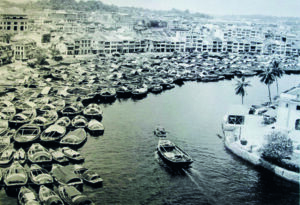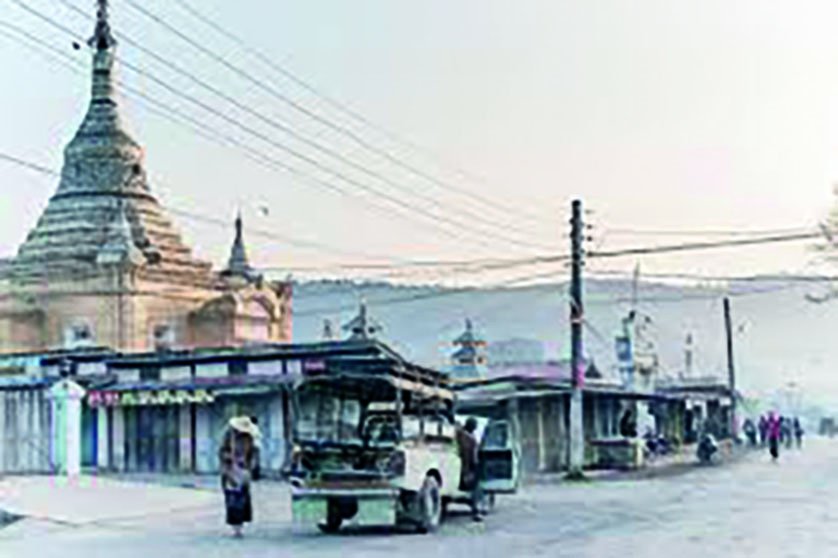Adil J. Govadia
 Rangoon:
Rangoon:
Trade between British India and Burma (Myanmar) began soon after the second Anglo-Burmese War of 1852. In addition to the territory that the British gained on the Arakan coast, during the first war of 1824-26, they also occupied what came to be known as Lower Burma and its strategic ports, situated on the delta of the Irrawaddy River. This led to enhanced trade between Burma and British India, for commodities like rice, pulses and Burma teak which was increasingly required for Bombay’s fast-developing shipping industry, pioneered by the Parsis.
In 1853, the nascent Indian railways developed the subcontinent’s first railway line between Bombay and Thana, using sleepers made of Burma teak. Similarly, the newly incorporated Great Indian Peninsula (GIP) Railway also laid sleeper-tracks using Burma teak that connected Bombay to its cotton hinterland (Nagpur), where Seth Jamshed N. Tata had pioneered his first enterprise – ‘The Empress Mills’.
With upsurge in trade with Burma, the Parsi population also increased, though the community was never in excess of 300 individuals in Rangoon and another 100 or so, dotting the countryside. As per a report, the earliest Parsis arrived around the 1850s, with Burjorji brothers of Calicut, being possibly the first Parsis given charge of the Postal System, by the local King. Likewise, Meherwanji Cawasji Captain, nicknamed ‘the Grand Old Man of Burma’ for his many achievements as a first-class magistrate and a Municipal Commissioner, was designated to pay homage to King George V, who was crowned on 22nd June, 1911.
According to Jam-e-Jamshed (29th August, 1904), Seth Bejonji Cawasji Khambata and Seth Hormusji Ferdoonji Contractor were the first to establish a small prayer hall in Rangoon, during mid-19th century. By 1878, the dilapidated Dadgah prayer-hall, needing urgent repairs, was refurbished by a noble Parsi – Seth Hormuzji Ferdoonji Contractor. However, by 1902, the walls of the primeval Dar-e-Mehr developed serious cracks on the verge of collapse. This prompted the magnanimous Seth Shapurji Cawasji Captain and his brothers – Seth Meherwanji and Seth Bomanji, to demolish the old structure and recreate a new edifice, at a cost of Rs. 35,000. The then Panthaky of Rangoon – Er. Bhikaji Diniarji Unwalla, alongside his priestly sons – Burjorji and Sorabji, carried out the ritualistic shifting of the Dadgah Saheb (Fire) which was re-installed on 20th August, 1904, in its full glory, in the newly built ‘Captain Atash Kadeh’ (Ref. ‘Parsi Dharmasthalo’ by Khan Bahadur B B Patel).
 Unfortunately, during the 1940s Japanese bombing, the ‘Captain Atash Kadeh’ was destroyed and only the 4-feet tall, silver Afarganyu (fire urn) could be retrieved. Though the fire-temple was re-established in another building, it was demolished again in early 1960s, by the local military regime place.
Unfortunately, during the 1940s Japanese bombing, the ‘Captain Atash Kadeh’ was destroyed and only the 4-feet tall, silver Afarganyu (fire urn) could be retrieved. Though the fire-temple was re-established in another building, it was demolished again in early 1960s, by the local military regime place.
The Parsi Aaramgah, built in 1858, on a one-acre property, was home to several Parsi-Zoroastrian graves. In 1995, the military regime forcibly took control of the land, moving Aaramgah outside Yangon. Whether the interred Parsi remains were preserved or relocated, is unknown. Almost 167 tombstones were retrieved and stacked in a storage shed. What exists today is a collection of grave headstones in bits and pieces, having barely legible English and Gujarati engravings, that offer a glimpse of the bygone era of the Parsi settlement in Burma. Recurring names retrieved among the pile of grave headstones include the Burjorjees, Saklats, Unwalas, Chinoys, Cowasjis, Sukhias, Narimans, Patels, Mehtas, Hormusjis, Masters, Masanis, Ghadialis, Manekshaws and JeeJeeBhoys.
Later, an alternative burial ground was allocated, where only two graves of the JeeJeeBhoy family – mother and son, exist today. (In Burma, the name Jeejeebhoy was spelt Jee Jee Bhoy in order to conform to three-part Burmese naming conventions.). The tale of Parsi lawyer – Seth P D Patel, who regularly accommodate Subash Chandra Bose, is captivating.
Singapore:
In 1819, Sir Stamford Raffles of East India Company first founded Singapore as a trading post that also served as a penal settlement under the British forces. Later, in 1826, Singapore, Malacca and Penang became British colonies under the ‘Straits Settlements’.
Seth Muncherji was the first Parsi to reach Singapore, in 1819, as a British prisoner who fell ill and abruptly died in 1829. His unexpected death led the China-based Parsi traders to hurriedly pool-in resources to purchase a burial plot. Thus, a Parsi Aaramgah was first established in 1829 at Mount Palmer in Tanjong Pagar, where the last known Parsi burial took place in 1869. There were almost 30 Parsi graves on the plot, of which only three are identifiable, that of Furmroze Sorabji (1849), Edulji Nusserwanji Muzgamwalla (1869) and Pestonji Pullonji Desai (1868). In 1969, the burial ground was moved to Tampines and then to Choa Chu Kang Cemetery, before relocating yet again across the road, where a prayer hall was also constructed for rituals and ceremonies, in 2007.
By the mid-19th century, more Parsis settled in Singapore, the more prominent ones being Seth Dhunjibhoy Hormusji, who, in 1854, served on the Grand Jury. Seth Cama of M/s Byramjee Hormusjee Cama & Company, opened an English school providing free education to local Chinese and other residents. Seth Edulji Khory, an advocate and solicitor, had the distinction of having a Masonic Lodge named after him in 1891 and Seth Heerji Pestonji Kaka founded one of the first Chinese newspapers in Singapore, in 1898.
Some notable Parsis buried in the Parsi Cemetery include magnanimous philanthropist – Navroji Mistri, after whom the Mistri Wing at the Singapore General Hospital was named; Seth Pesi Davar – the shipping magnate; and Nargis Medora – former President of the Leprosy Association. Even today, the road adjoining Mistri’s factory is called ‘Mistri Road’, whereas the one adjacent to the Parsi burial ground is called the ‘Parsi Road’.
- કેવો સુંદર જવાબ! - 29 March2025
- પારસી સન્નારીઓ તેમના જાદુઈ સ્પર્શ સાથે બની સુરત મેરિયોટ અથવા લાઇન્સના રસોડાની રાણીઓ - 29 March2025
- મોબેદ મેહરાબાન ફિરોઝગરીનું અવસાન - 29 March2025
